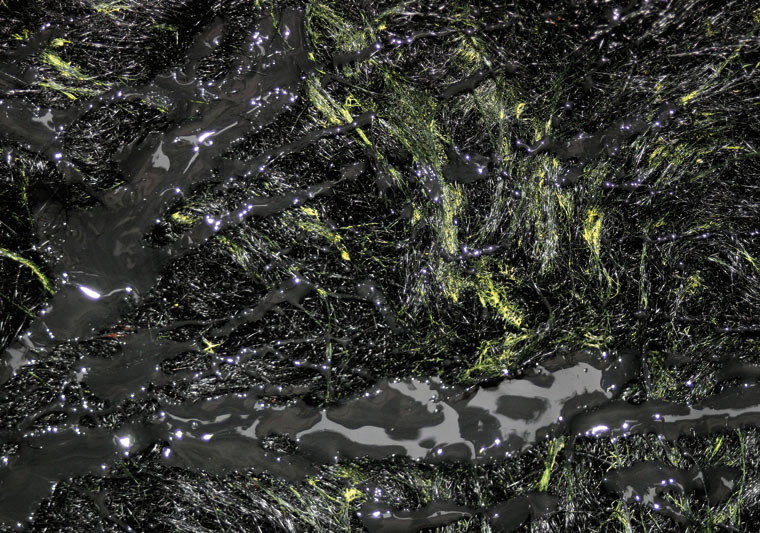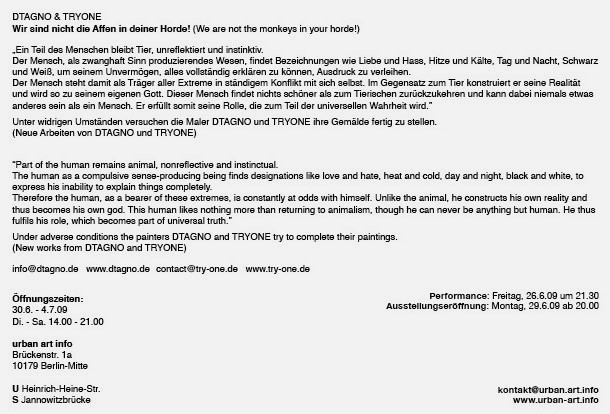WIR SIND NICHT DIE AFFEN IN DEINER HORDE!
26.06. - 04.07.2009


“Part of the human remains animal, nonreflective and instinctual. The human as a compulsive sense-producing being finds designations like love and hate, heat and cold, day and night, black and white, to express his inability to explain things completely. Therefore the human, as a bearer of these extremes, is constantly at odds with himself. Unlike the animal, he constructs his own reality and thus becomes his own god. This human likes nothing more than returning to animalism, though he can never be anything but human. He thus fulfils his role, which becomes part of universal truth.” (DTAGNO and TRYONE)
Artist – Artwork – Gallery
In their performance at urban art info, DTAGNO and TRYONE question the fundamental potential and constraints of artistic production in respect to the themes “artist,” “artwork” and “gallery.”
During their performance, DTAGNO and TRYONE wear monkey costumes and are equipped with palette, brush and easel, a beret and glasses of red wine. This disguise allows them to “ape,“ or spoof, themselves as producing artists. At the same time, it refers to the monkey in the artist: a wild animal that lives inside him, and surprises him with its unpredictability and its creative potential.
These “monkey artists“ are trying to paint self-portraits. The sophisticated subject matter proves that the humans are doing the painting here. Their wild costume refers to an artist’s ideal: to switch off the will and the mind, and trust in instinct, drive and feeling while painting.But paint bombs blasting inside the walls make it difficult for them to finish their works. The gallery owner triggers these explosions by using a device made by the artists. He holds the monkeys at bay like a tamer and so interrupts the emergence of the art. The bombs leave traces of paint on the portraits, and to some extent, covers their original form. Beyond that, the paint transforms the whole room: the „white cube,“ the clean, isolated gallery room, little by little turns black.
During the performance the audience members stay outside. From there they hear, despite the explosions, the music of the “devil-like” violinist Paganini. They watch the spectacle through the gallery windows, which are covered with a foil that is decorated with the Brandenburg Gate. It is the very same foil the Berlin Transport Authority uses to protect the subway windows from vandalism. The gallery has a new skin: Its windows refer to oversized train windows.
When you enter the gallery, you find yourself on a “battle field”: Everything is covered in black paint, broken glass lies on the floor, the explosive charges holed the walls... The portraits on canvas are still on their easels. They neither show monkeys, nor do they indicate the artists’ outer appearance. Their paint-splattered surface is rather a snapshot of the artists in action. The whole installation of easels, portraits and painting equipment in original location represents a document of the performance. It is completed by a movie that shows the artists in action. The monkey costumes on the other hand are presented trophy like in a whitened part of the wall.
Human – Animal – God
“Long live relativism!” (DTAGNO and TRYONE)
The humans’ attempt to become his own god by constructing his reality succeeds. But his effort to reach a truth, which is relevant for everybody, meaning absolute, fails. That is because every human constructs his own reality and as a result everyone lives in a different reality. The truth is always dependent on one’s relative construction of reality.
But he human bears two sides: The genuine and immediate simplicity of an animal, and the intellectual, artificial, constructed world. Since the animal does not construct his own reality, it might still have access to absolute truth. That is where the humans’ desire to revert to the animal comes from.
Text by Iris Hempelmann
Edition: BVG Antiscratchfolie
















